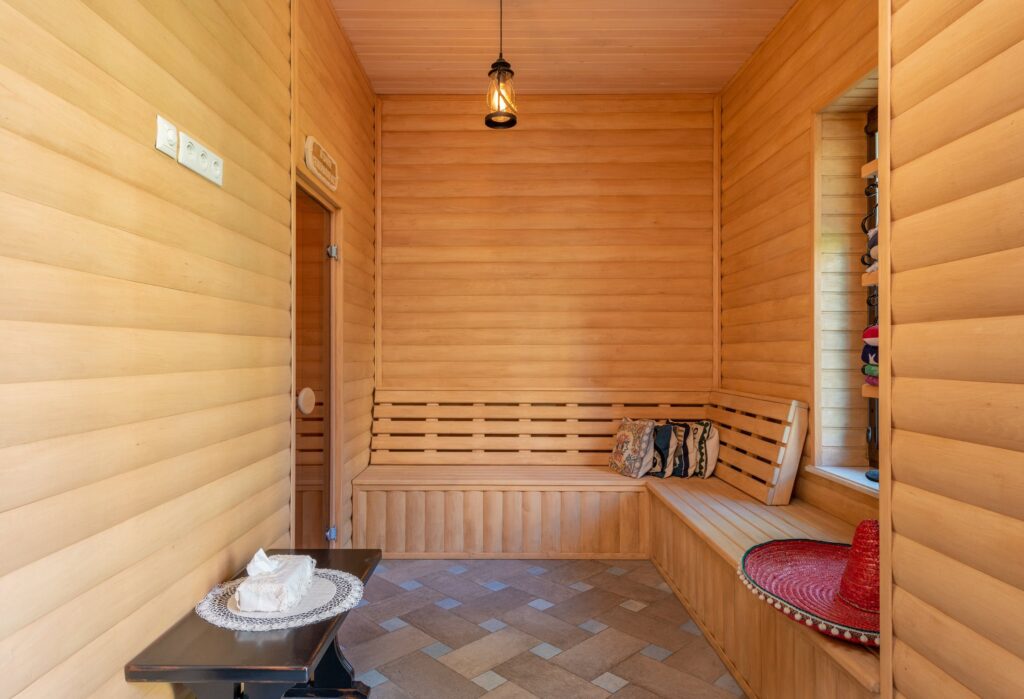Sweating, a flushed face, and the feeling that your skin is going to melt or dry out are all signs that the temperature outside is too high. It's possible that this will alter your perception in some unusual way. Nonetheless, many people cannot get enough of steam rooms and saunas. According to Dr. Chiti Parikh, co-director of the integrative health and wellbeing program at New York Presbyterian Weill Cornell Medical Center, the hot chambers may in fact have some health benefits.
What are the health benefits of utilizing a sauna versus a steam room, and which one is better? How do you determine which alternative best meets your needs? Let's start with the most basic information.
Taking use of a sauna is one of life's finer moments. Only a session in the sauna can provide the same sense of relaxation and rejuvenation, especially after a long and taxing workweek. This is arguably the most important factor in deciding whether or not to install a sauna in one's home, and it's also one of the few things that can compare to the experience of taking a sauna. To help you decide between a steam sauna and an infrared sauna if you're considering putting one in your home, here are some things to consider. So what, exactly, distinguishes a steam sauna from an infrared sauna, and is one form of sauna intrinsically preferable to the other?
It's true that a sauna is an expensive investment, but the positive effects on your mood and health more than justify the cost. If you decide to sell your home in the future, you may be able to get more money for it thanks to its improved value. Do your homework to ensure the sauna you choose is a suitable fit for your needs and preferences before making a final decision. In order to help you decide which type of sauna is best for you and to make a more informed purchase decision, let's compare and contrast traditional saunas with infrared saunas and discuss the advantages and benefits of both.
Differentiating the advantages of a steam room versus an infrared sauna might be difficult when trying to choose which option will be most beneficial for your specific needs. To help you better realize how these two types of saunas relate to one another, it is vital to get a general understanding of the operations and benefits of both infrared saunas and steam rooms. Check out Portable Sauna Melbourne specialists in providing solutions to your problem.
The infrared rays used in an infrared sauna are not visible to the naked eye, yet they warm the person evenly and thoroughly from the inside out. Steam rooms are enclosed spaces that are kept at a high, constant temperature by use of a steam generator and whose walls are built of impermeable material. As comparison to steam rooms, the heat produced by an infrared sauna is much less humid.
FAQs About Sauna
Take a warm shower just before your sauna session so you don't bring any dirt in. It also helps to open your pores and relax your muscles. But remember to dry completely off to sweat more quickly.
Saunas are excellent for relaxation and relieving tense muscles. Meanwhile, steam rooms have further benefits from the moist heat and humidity such as skin moisturizing, congestion relief, and reduced muscle soreness.
Improves heart function: A study has shown that regular saunas may improve heart function in people with heart failure. Another study has shown that using a sauna 4-7 times a week can significantly lower the risk of sudden cardiac death and other heart diseases.
If you want to get the best out of your sauna time for your sleep therapy needs, start by going to the sauna before bed. Ideally, step in for a sauna session 15 minutes prior to bedtime. This will raise your body temperature to the right degree range for promoting muscle relaxation and sleep-inducing response.
A sauna is an excellent way to flush out various toxins that collect in the fat cells of the body. When you sit in a sauna, you excrete a massive amount of perspiration. This high level of sweating is important because it eliminates one-third of the toxins from the kidneys.
What Is a Sauna
The term "sauna" is often used to describe any type of heated environment intended to produce profuse sweating, but it has a more specific meaning.
The origins of saunas can be traced back to prehistoric Finland, about the year 7000 BC. There is evidence that the earliest saunas, which were dug into the earth, were lined with stone.
Today's saunas typically feature a timber frame and some sort of infrared heater, fire, or electrical element. These might occur in a variety of settings, both indoors and out. Also, the Portable Sauna Melbourne page has everything Portable Sauna related that you might need
There is a wide variety to choose from, from traditional steam saunas and steam rooms heated by hot stones to the most cutting-edge, cutting-edge infrared therapeutic saunas accessible today.
Sound systems, Bluetooth® compatibility, and mood lighting are commonplace in today's most cutting-edge saunas. Then there are the final touches, which include things like paint and wood species.
Saunas produce their dry heat by using electrical resistance heaters. They often reach temperatures between 180 and 195 degrees Fahrenheit with extremely low relative humidity and are heated with wood, gas, electricity, or infrared technology (a.k.a., using light to create heat).
When Do You Need an Infrared Sauna?
To heat the body without subjecting it to severe heat or humidity, an infrared sauna makes use of a wooden chamber and infrared rays. These photons produce an inside rather than an outside source of heat. These infrared rays are bio-identical and can penetrate the body quite deeply (about 1.5 inches), where they cause instantaneous heat.
The recommended temperature range for these saunas is between 115 and 130 degrees Fahrenheit, which is considerably colder than the 170 to 200 degrees Fahrenheit at which traditional saunas function. You'll feel toasty and cozy from the inside out thanks to the infrared rays. One of the most viable possibilities is an infrared sauna, which, unlike traditional saunas, can effectively heat the body at a lower temperature.
To relax, purify, and improve one's health, many people turn to infrared saunas, which are essentially wooden rooms heated from within with infrared heaters.
Instead of using steam or dry heat to generate heat, as is done in traditional saunas, infrared saunas employ cutting-edge infrared heaters to warm your body directly. You'll break out into a more profound, calming sweat as a result of your body's increased thermal energy as a result of absorbing infrared heat.
Using an infrared sauna has been demonstrated to boost health in a number of ways, including reducing pain, enhancing sleep, flushing out toxins, loosening up stiff joints, reducing stress, and increasing blood flow, among other benefits.
What Is a Steam Room?
Steam rooms are enclosed spaces often made of nonporous materials like glass or tile that prevent the passage of air. It's meant to warm you up by subjecting you to intense heat and moisture. Water is heated in a steam generator until it boils, and the resulting steam creates a humid environment.
Averaging approximately 120 degrees Fahrenheit, the extreme humidity (which sometimes reach 100%) makes it feel much hotter. When you enter a steam room, you'll feel warm from the outside in because the environment is heated instead of you. Contrast this with infrared saunas, which heat the user from the inside out.
The typical steam sauna is the first thing that comes to mind when you mention the word "sauna" to the average person. This little room contains a furnace for heating pebbles, and the space is otherwise unusable. Water is poured over the rocks after they reach the desired temperature in order to generate steam. In the center of the room, where the stones are stacked, there is a fire pit that gives the traditional sauna its log cabin aspect. Modern steam saunas frequently make use of glass or similar impermeable material in their construction. This is regarded to be more efficient than employing porous materials like wood, which can absorb moisture and transfer it elsewhere in the space. The old method of pouring water over hot pebbles in an oven to produce steam has been rendered obsolete by the advent of the modern steam generator.
Steam saunas are designed to produce an environment that is both extremely hot and extremely humid. Because of the high amounts of humidity found in steam saunas, their users can reap a number of health benefits. In addition, it offers a feeling that's really different from what you'd get in an infrared sauna.
Which Is It, and Why?
While both infrared saunas and steam rooms have been shown to have health benefits, there are important characteristics between the two types of saunas that should be taken into account when evaluating their relative merits. The main differentiation is determined by the nature of the heat generated in each environment. Dry heat and moist heat are two distinct forms of thermal energy. Florida in July may feel like Arizona in the dead of summer (sauna). While we agree that both of these services are great complements to your time at the gym, we'd want to spend some more time discussing how they differ and how you can use them to get the most out of your exercises.
Indication of Steam Availability
An ordinary steam sauna gets its moniker from the steam it generates. That makes me long for a group experience, with everyone swathed in towels and sharing a same moment. Humidity and heat permeate the area, making it feel like you're sweating off any toxins. In traditional saunas, hot rocks are used to generate steam, which fills the entire space. Saunas can also have steam supplied to it by hooking up external steam generators.
There is also a wide selection of dry saunas that can be heated by a stove or another source of heat.
For this reason, saunas tend to get quite hot.
Scientific studies have shown that adding steam to a sauna helps people clear their nasal passages and purge their lungs of dust and other debris.
Also, the steam may aid in pore opening, which is an additional step that can help in the process of eradicating skin concerns.
Some people use the term "infrared sauna" to refer to a dry sauna. This is because their heat is not just dry, but also produces waves of invisible infrared radiation.
An infrared sauna foregoes the use of hot rocks or burners in favor of electricity and infrared radiation to warm the chamber.
Temperature
Steam saunas are typically more hotter than infrared saunas because of the combination of the steam and the various heating systems used in steam saunas. The amount and type of warmth desired are, of course, matters of personal preference. The high temperatures in a steam sauna mean that users typically spend less time in the room than in a traditional sauna. In both saunas, you may expect a similar degree of perspiration. Sweating in a steam sauna is beneficial because it helps the body rid itself of toxins that have been accumulated in the skin by opening the pores.
To the very depths of your being, infrared light can penetrate. Your body's temperature rises as a result, and that helps with the detox process. Because of this, the sweating reaction can be stronger than in a steam sauna, even if the temperature is lower.
Even while an infrared sauna's interior temperature is often lower than that of a steam sauna, it's still rather toasty in there. But, the heat is far more manageable, so you may spend more time in the sauna, reaping the full benefits of your time there.
Traditional "hot rock" or steam saunas need temperatures between 70 and 80 degrees in order to induce perspiration. By comparison, an infrared sauna's internal air temperature can be well below 60 degrees and still induce detoxifying sweating in significant amounts.
Unlike traditional saunas, which may achieve temperatures of up to 85 degrees Fahrenheit, infrared saunas operate at temperatures between 46 and 57 degrees.
For the same amount of time spent in the sauna, you can reap greater advantages from exposure to infrared light, which is more comfortable to be around.
Humidity
The moist air that is circulated within a steam sauna is what causes the enhanced impression of humidity. There are a lot of people who prefer it when the air is slightly damp. They say it helps them breathe easier and purifies their skin.
A dry heat environment like that found in an infrared sauna means that there is no humidity to speak of while you're in there.
They are having a much better time, and the trip is much more manageable, according to several of our customers.
Excessive Perspiration Time
We know now that certain people can't take the steam, heat, and humidity of a sauna's steam room. Due of the two factors working together, it may be challenging to spend long periods of time indoors, which is why sessions are often about 15 to 20 minutes in length. It's fine to take short breaks in between sauna sessions, but the heat needs to be maintained at a steady state throughout to produce the desired perspiration levels.
The optimal duration of an infrared sauna session is forty minutes. Even if the raised heart rate and sweating that occur near the end of the encounter can be difficult to manage, the experience is still pleasant because the air never gets too stuffy. The experience has profound effects on the cellular level because infrared radiation penetrate so deeply into the body. Saunas like these are great for removing heavy metals and can help improve your mitochondrial health.
Customers often remark on how much better they feel after only one session of our program, and this is because the sweating travels deeper than the skin's surface.
A Look at the Many Costs of Saunas
The final price of a sauna depends on many factors, including the model you choose, its size, the quality of the wood used, the sophistication of the technology (including the heaters), and the inclusion of any number of optional extras.
An infrared sauna can cost anywhere from $2,500 for a simple unit to over $10,000 for a high-end model. Investigate how much infrared saunas typically cost.
The price of an infrared sauna is far less than that of a traditional steam sauna. The reason for this is because a skilled specialist is required for the construction of a classic steam sauna (as was discussed earlier).
This explains why the cost of a steam sauna is typically double or triple that of an equivalent infrared device, at $10,000 to $30,000.
To put it another way, a decent mid-range infrared sauna that provides all of the additional benefits that infrared gives can be purchased for around $8,000, while a comparable mid-range steam sauna can be purchased for over $15-20,000. We think that's a lot of money to pay for the warm air and steam.
In sum, we think it's crucial to evaluate cost-effectiveness when comparing regular saunas to infrared saunas. Compared to a typical sauna, an infrared sauna provides numerous health benefits at a far lower price.
The Benefits of a Sauna
Traditional saunas and infrared saunas also differ in how they make you feel when you're inside of them.
Most people can only handle the heat and humidity of a traditional sauna for a limited amount of time.
With temperatures reaching up to 80 degrees, they are usually only bearable for a maximum of twenty minutes at a time. Some people like to cool off in the pool or under a cold shower after they've used the sauna, while others prefer to repeat the process several times.
Infrared saunas, on the other hand, provide heat that is not only dry but also soothing and relaxing; you may spend at least forty minutes in one without feeling any ill effects. In most cases, the temperature is kept between 50 and 60 degrees, and there is virtually no humidity.
Infrared sauna heat is more gentle than traditional sauna heat, yet it still causes profuse, cleansing sweating. Relax for longer periods of time and get the most out of your workout by maintaining a comfortable body temperature with this. Are you looking for the Melbourne Sauna? Look no further, Portable Sauna has you covered.
Whether one sauna is better than another depends on a number of things, including the intensity and duration of the heat you desire and the effect you hope the sauna will have on your body.
Do you want to get hot and sweaty in no time at all? Would you rather have a shorter, wetter, and less comfortable session, or a longer, deeper, more powerful, and more therapeutic sweat?
Again, this is a matter of personal preference, and no one but you can tell for sure which choice is best. What is our recommendation? Give each one a try and see which one you like better before making a final decision.
Differences Between a Steam Room and a Sauna
Both infrared saunas and steam rooms work by increasing your core temperature, which in turn stimulates your body to release accumulated toxins. The typical temperature in a steam room is around 120 degrees Fahrenheit or lower, whereas modern infrared saunas can reach temperatures of up to 140 degrees. A sauna, as contrast to a steam room, is traditionally made out of wood. To prevent the steam from escaping, a steam room's walls and floor might be lined with nonporous materials like glass or tile. The steam chamber then uses an electrical generator to keep the temperature and humidity at a constant near-one hundred percent. This causes the internal temperature of a steam chamber to feel much greater than it actually is. Hence, a sauna-like environment can be effective without having so extreme a heat setting. That's why, even though you'd sweat a lot more in a steam room, it's likely you wouldn't be subjected to quite as much heat.
Which Of The Two Is Better, A Sauna Or Steam Room?
Dr. Parikh recommends that people who already have breathing difficulties avoid saunas in favor of steam rooms because the latter are better at keeping the respiratory tract moist. Eating either can be good for your health, so it really simply boils down to your personal preference.
Last thought: a steam sauna and a modern infrared sauna are two completely different experiences.
These three share similarities, but they are put to use in different ways to provide the body with unique benefits.
There is, however, a growing trend (among which we are included) of preference for an infrared sauna. The typical steam sauna has a special place in the hearts of traditionalists.
Adding infrared wavelengths increases the device's ability to reach deeper tissues. Because of this, there is a more robust metabolic response, allowing for more complete detoxification.
The waves have a beneficial effect on musculoskeletal pain in addition to boosting pain relief, improving cardiovascular health, and helping with weight loss.
Using a steam room or an infrared sauna can provide considerable and much-needed health advantages for individuals and households. Improved health and happiness are only two of the many benefits that might accrue from spending time in one of these spaces, along with less stress and increased relaxation. In other words, they can be a great benefit to one's home and way of life.
Before settling on an infrared sauna or steam room, it's important to do some research and consider the specific needs of you and your family. So, in what part of your house do you foresee this new construction being installed? If you could describe your current health situation and your hopes for the future, what would they be? Do you plan on completing the installation on your own, or will you be employing a professional? When considering the benefits of an infrared sauna over a steam room, it's important to first determine your individual needs.
Conclusion
A sauna is an expensive investment, but its positive effects on mood and health more than justify the cost. Saunas are a type of heated environment intended to produce profuse sweating, with steam rooms and infrared saunas being two distinct types. An infrared sauna uses infrared rays to heat the body without subjecting it to severe heat or humidity, allowing it to feel toasty and cozy from the inside out. Steam rooms use steam or dry heat to generate heat, but infrared saunas use cutting-edge infrared heaters to warm the body directly. Steam saunas are designed to produce an environment that is both hot and humid, offering health benefits and a feeling that is different from an infrared sauna.
Dry saunas can be heated by a stove or other source of heat, producing waves of invisible infrared radiation to warm the chamber. Steam saunas are typically hotter than infrared saunas due to the combination of steam and heating systems. The optimal duration of an infrared sauna session is forty minutes, and it has profound effects on the cellular level, such as removing heavy metals and improving mitochondrial health. The cost of a steam sauna is typically double or triple that of an equivalent infrared device, making it important to evaluate cost-effectiveness when comparing regular saunas to infrared saunas. Sauna vs. Steam Room: Which is better for people with breathing difficulties? Heat saunas and infrared saunas offer unique benefits, such as improved health and happiness, as well as reduced stress and increased relaxation.
Content Summary
- What are the health benefits of utilizing a sauna versus a steam room, and which one is better?
- To help you decide between a steam sauna and an infrared sauna if you're considering putting one in your home, here are some things to consider.
- Do your homework to ensure the sauna you choose is a suitable fit for your needs and preferences before making a final decision.
- In order to help you decide which type of sauna is best for you and to make a more informed purchase decision, let's compare and contrast traditional saunas with infrared saunas and discuss the advantages and benefits of both.
- Differentiating the advantages of a steam room versus an infrared sauna might be difficult when trying to choose which option will be most beneficial for your specific needs.
- To help you better realize how these two types of saunas relate to one another, it is vital to get a general understanding of the operations and benefits of both infrared saunas and steam rooms.
- Check out Portable Sauna Melbourne specialists in providing solutions to your problem.
- Also, the Portable Sauna Melbourne page has everything Portable Sauna related that you might needThere is a wide variety to choose from, from traditional steam saunas and steam rooms heated by hot stones to the most cutting-edge, cutting-edge infrared therapeutic saunas accessible today.
- To heat the body without subjecting it to severe heat or humidity, an infrared sauna makes use of a wooden chamber and infrared rays.
- What Is a Steam Room?Steam rooms are enclosed spaces often made of nonporous materials like glass or tile that prevent the passage of air.
- When you enter a steam room, you'll feel warm from the outside in because the environment is heated instead of you.
- Contrast this with infrared saunas, which heat the user from the inside out.
- Steam saunas are designed to produce an environment that is both extremely hot and extremely humid.
- Because of the high amounts of humidity found in steam saunas, their users can reap a number of health benefits.
- Which Is It, and Why?While both infrared saunas and steam rooms have been shown to have health benefits, there are important characteristics between the two types of saunas that should be taken into account when evaluating their relative merits.
- The main differentiation is determined by the nature of the heat generated in each environment.
- Dry heat and moist heat are two distinct forms of thermal energy.
- There is also a wide selection of dry saunas that can be heated by a stove or another source of heat.
- Some people use the term "infrared sauna" to refer to a dry sauna.
- The optimal duration of an infrared sauna session is forty minutes.
- Investigate how much infrared saunas typically cost.
- The price of an infrared sauna is far less than that of a traditional steam sauna.
- Compared to a typical sauna, an infrared sauna provides numerous health benefits at a far lower price.
- Whether one sauna is better than another depends on a number of things, including the intensity and duration of the heat you desire and the effect you hope the sauna will have on your body.
- Again, this is a matter of personal preference, and no one but you can tell for sure which choice is best.
- Give each one a try and see which one you like better before making a final decision.
- Differences Between a Steam Room and a SaunaBoth infrared saunas and steam rooms work by increasing your core temperature, which in turn stimulates your body to release accumulated toxins.
- The typical temperature in a steam room is around 120 degrees Fahrenheit or lower, whereas modern infrared saunas can reach temperatures of up to 140 degrees.
- A sauna, as contrast to a steam room, is traditionally made out of wood.
- Hence, a sauna-like environment can be effective without having so extreme a heat setting.
- Which Of The Two Is Better, A Sauna Or Steam Room?Dr.
- Parikh recommends that people who already have breathing difficulties avoid saunas in favor of steam rooms because the latter are better at keeping the respiratory tract moist.
- Eating either can be good for your health, so it really simply boils down to your personal preference.
- Using a steam room or an infrared sauna can provide considerable and much-needed health advantages for individuals and households.
- Before settling on an infrared sauna or steam room, it's important to do some research and consider the specific needs of you and your family.
- When considering the benefits of an infrared sauna over a steam room, it's important to first determine your individual needs.






